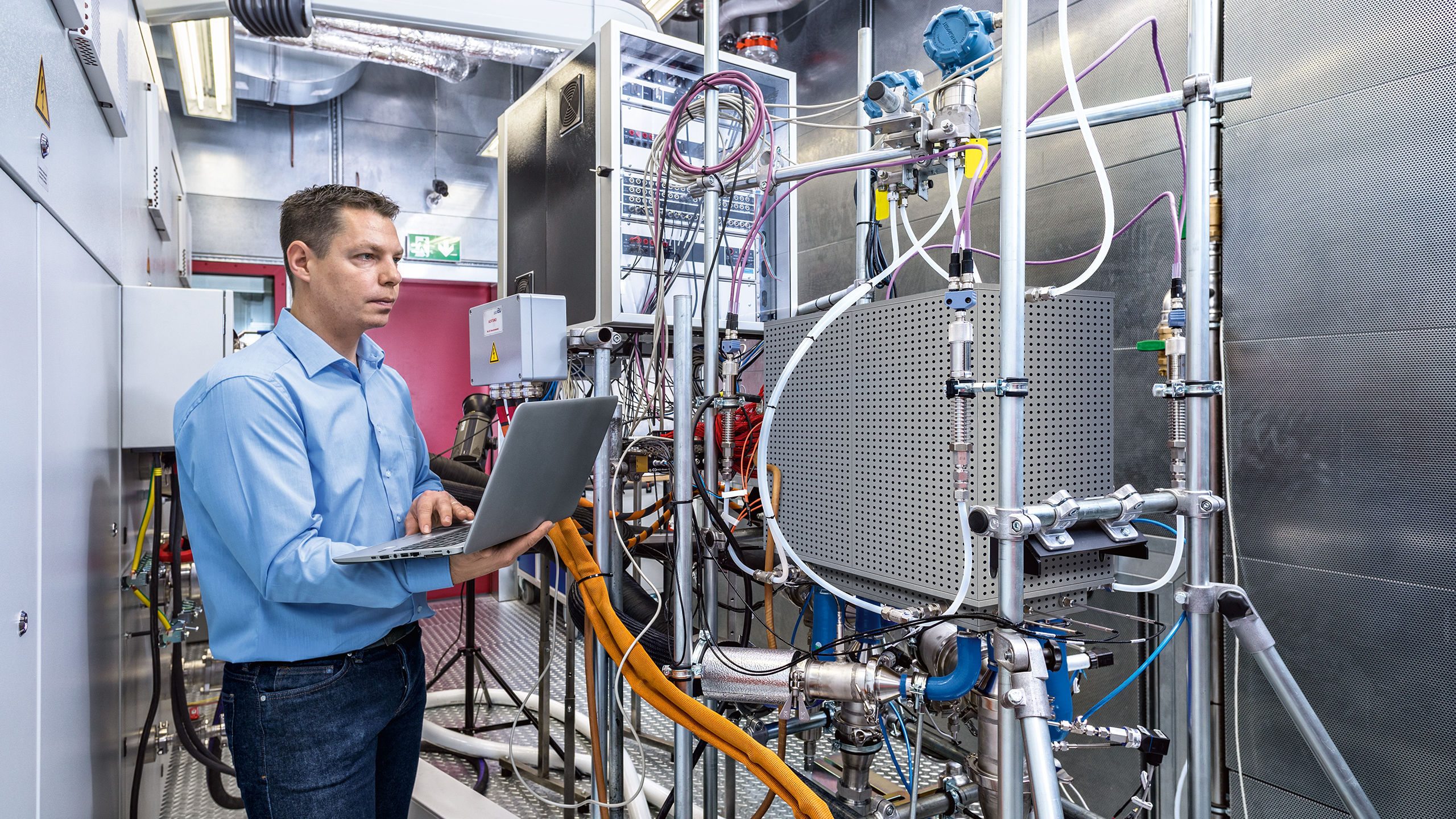Cutting-Edge Fuel Cell Test Bench for Production-Ready Engineering
High output and dynamics – designed for developing fuel cell systems, fuel cell stacks and peripheral components
The new test bench at the Development Center in Gifhorn bolsters our proficiency in developing fuel cell vehicles. The test bench is designed for mobile applications with hydrogen-powered PEM fuel cells and lets our developers carry out their tests and investigations under near-vehicle and dynamic operating conditions. The test bench is suitable for production-ready development activities, but is also used for projects from the fields of ad- vance engineering and research.
Fuel cell vehicles are a particularly convenient and efficient form of e-drives. “They can be refueled in just a few minutes, provide large cruising ranges and are also ready for operation at low temperatures”, says Ralf Wascheck, head of the Fuel Cell Systems department at IAV. “Added to this is the close association with renewable energies: hydrogen will become the central medium for storing electricity from renewable sources and, as such, be available in large quantities.”
In the meantime, automobile manufacturers are forging ahead with the fuel cell which, at IAV, is reflected in a rapid growth of associated development services and testing activities. Fuel cell vehicles allow OEMs to cut the CO2 emissions from their vehicle fleets without having to compromise in any way on ride comfort. “This makes me certain that fuel cell drives will become established”, Wascheck says.

Versatile applications
IAV’s Gifhorn operation now has a modern test bench for PEM fuel cell stacks and systems. This test bench can also be used for investigating peripheral fuel cell system components, such as humidifier, compressor or recirculation blower. The test bench is rated for maximum electric power outputs of 180 kilowatts (stack) and 150 kilowatts (systems) respectively.
The media fed to the system under review can be conditioned over wide operating ranges, for example to examine the influence of pressure, temperature and humidity on performance. The concentration of hydrogen can also be varied, making it possible to simulate nitrogen enrichment in the fuel cell in the vehicle. A highly dynamic single-voltage measurement system and an impedance measuring system are used for analyzing stack characteristics, such as internal resistances.
Different test cycles
The new fuel cell test bench can be used for endurance tests (for example degradation tests), function tests as well as for characterizing and rating fuel cell systems (operating modes and control). It is designed for 24/7 operation and integrated in IAV’s high-efficiency testing environment. “The new fuel cell test facility lets us simulate cycles that are very similar to real vehicle operating conditions”, Ralf Wascheck reports. “Yet at the same time, the test bench can also be matched to brand-specific cycles.”
The fuel cell test bench is linked to IAV’s facility for overall vehicle simulation, making it possible to examine various operating strategies and their impact on parameters, such as hydrogen consumption and cruising range.
Expertise in fuel cell vehicles and components
Work is already in progress on initial customer projects and demand is showing that IAV clients are hugely interested in the new test bench. “Fuel cell drives are a key topic for IAV”, says Wascheck, summarizing. “We have a broad range of fuel cell expertise at IAV and were quick to develop competencies in developing entire fuel cell vehicles and their components. The new fuel cell test bench for testing high-performance and dynamic aspects complements our service portfolio.”
Technical Specifications
| Maximum output, fuel cell system: | 150 kW |
| Maximum output, fuel cell stack: | 180 kW |
| Maximum voltage: | 1,000 V |
| Maximum current: | 1,000 A |
| Maximum cooling capacity: | 250 kW |
| Maximum air volume flow: | 10,000 SLPM |
| Maximum hydrogen volume flow: | 4,100 SLPM |
| Control accuracy of media supplied: | ≤1%FSR |
| Dew point of added media: | up to 80 °C |
- E-Mobility
- Hydrogen & Fuel Cell
- Powertrain Development
